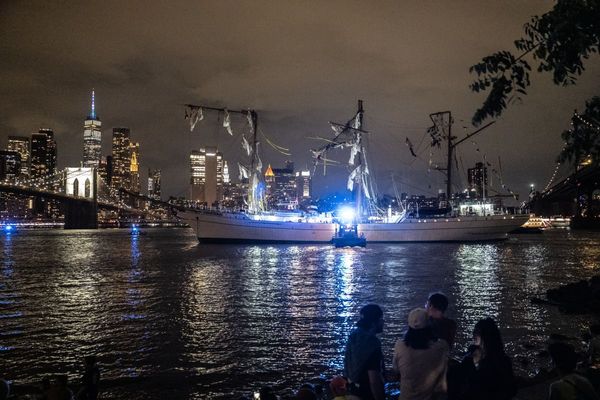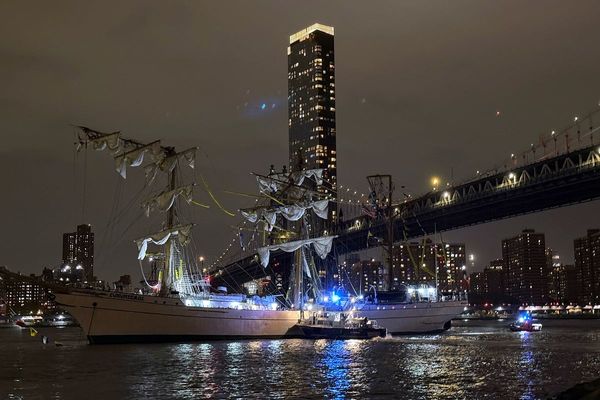
OBANAZAWA, Yamagata -- Along a river flowing through a valley surrounded by sheer mountain slopes in Obanazawa, Yamagata Prefecture, a row of ryokan inns are illuminated by gaslights. The scene perfectly encapsulates the concept of "Taisho roman," a term used to express cultural trends of the Taisho era (1912-1926).
Lining the river for only about 300 meters, the small Ginzan Onsen hot spring resort has been attracting a lot of attention in recent years among tourists lured by the nostalgic scenery.
When I alighted from a bus on a chilly day in February, the gentle sound of the babbling river was a wonderful welcome.

Naoko Totsu, 44, an official of the Ginzan Hot Spring Tourist Information Center and local tour guide, showed me around.
"This onsen has a history going back 400 years, in connection with a local silver mine [Nobesawa Ginzan] that was prosperous in the Edo period."
The mine was discovered in the Muromachi period (1336-1573). During the Edo period (1603-1867), there were as many as 20,000 people living in the area.

It was during those peak years that the hot springs were developed as the spring water was believed to heal fatigue.
Even though the silver mine fell into decline -- partly due to repeated collapses -- deep in the mountains, the complex of ryokan inns has remained in operation as a hot spring resort.
Many of the existing buildings there were constructed in the Taisho era and early Showa era (1926-1989): all have facades featuring multicolored "kote-e" reliefs depicting seasonal scenes.

One ryokan inn had a sign which said "uchiyu ari," bathroom available. A remnant of an era when the spring water was in short supply. The sign let passersby know that the inn had its own pipes that it used to draw spring water directly from the source.
The volume of hot water increased after the introduction of boring in the early Showa era. Currently, 13 ryokan inns belonging to an association of onsen operators jointly use the source spring.
I visited the Ginzanso ryokan because I had heard that the inn has a bath open to day trippers. "This inn was almost empty before," recalled Kichizaemon Koseki, 64, the 14th-generation owner of the inn.
When Japan's bubble economy flourished about 30 years ago, this old hot spring resort fell behind the times.
In an effort to survive, Ginzanso installed an open-air bath so that guests could enjoy the snow-covered scenery while they bathed.
Business owners also converted a public bathhouse in the central part of the resort into a foot spa facility, so that visitors could effortlessly enjoy the spring water. Additionally, electricity poles were removed and electricity cables were placed underground in consideration of the landscape.
Taisho chic
Amid a recent boom in undiscovered hot spring resorts, ironically, Ginzan Onsen has become a tourist spot visited by 380,000 people per year.
Shivering in the frigid air, I settled into an open-air bath and was overwhelmed by the panoramic view of snow-covered mountains.
Locals said bathers sometimes see bears or deer on the mountain slopes.
As dusk descended, the warm light from gas lamps reflecting off the snow created a nostalgic atmosphere.
I also visited public bathhouse Shirogane-yu, which was designed by Kengo Kuma, architect of the New National Stadium.
The building, which stands on a small triangular plot of land, has a bold design featuring a facade made up of strips of black wood that adds to the mystery of the retro streetscape.
Resting in a triangular bathtub full of hot spring water, I felt my fatigue from a day's work disappear.
"In winter, what can be done here is no more than relaxing in a bath of hot spring water," Totsu said.
Visitors can view new green leaves in spring, the refreshing river in summer and colorful leaves in autumn, she added, so there is something to enjoy in every season.
There are areas that are closed in winter because of deep snow, such as the pit of the silver mine, which still remains. Perhaps I'll save that for my next visit.
At I'rasgayna, a costume rental shop on the resort's main street, hakama trousers can be rented, giving visitors an opportunity to fully reflect the town's "Taisho roman" character by wearing clothing commonly worn in the era.
The service has become popular among young people eager to post images on the Instagram photo-sharing service. Hakama featuring a yagasuri feather motif are popular among women, and kimono with an image of students in the Taisho era are popular among men.
Shop clerks help customers put the traditional Japanese clothes on so anybody can easily enjoy wearing the outfits of "haikara-san," as stylish youths of the Taisho era were known.
Rental costs 1,500 yen per hour. The service is available for all customers from mid-April to mid-November. In winter, the service is available only for guests of Ginzanso.
Yamagata Prefecture produces a large amount of soba buckwheat noodles, utilizing the region's clean water and climate.
Popular soba noodle restaurants are concentrated on "soba kaido" street, which mainly runs along Mogamigawa river.
Ginzan Onsen's Izu no Hana, which serves soba noodles and sake, is one of the resort's most well-known restaurants.
The restaurant uses buckwheat flour made from a variety called mogami wase. The buckwheat grains and chaff are ground by a stone mill, giving the noodles a unique firmness.
I ordered "agenasu oroshi soba," a popular dish at the restaurant priced at 1,200 yen plus consumption tax. The noodles are topped with slices of fried eggplant from a local farm. The dish comes with a homemade seasoning of soy sauce mixed with a bonito-based dashi stock. The relatively light flavored sauce complements the simple taste of the eggplant and sweet flavor of the soba noodles.
The restaurant also serves "soba soft," soft-serve ice cream made from the same variety of buckwheat flour, priced at 410 yen for customers who eat in the restaurant.
Read more from The Japan News at https://japannews.yomiuri.co.jp/







